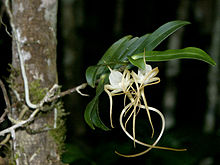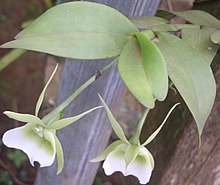Angraecum
| Angraecum | ||||||||||||
|---|---|---|---|---|---|---|---|---|---|---|---|---|

|
||||||||||||
| Systematics | ||||||||||||
|
||||||||||||
| Scientific name | ||||||||||||
| Angraecum | ||||||||||||
| Bory |
Angraecum is a plant genus in the family of orchids (Orchidaceae). The approximately 225 species mostly grow epiphytically in tropical Africa , Madagascar and other islands in the Indian Ocean . Occasionally they arecultivatedas ornamental plants, they produce predominantly white colored flowers .
description

Vegetative characteristics
The Angraecum species have a monopodial , rarely branched stem axis . This can be compressed or form longer internodes , grow upright or drooping. In the lower area there are long aerial roots covered by velamen . The leaves sit in two rows on the shoot and are separated from this by a separating fabric. The leaf base encompasses the shoot in such a way that it is completely covered by the leaf bases. They unfold conduplicate , the midrib stands out clearly. The shape of the leaves is often lanceolate with a leathery texture. In some species the leaves are succulent and round or V-shaped in cross-section. The tip of the leaf is drawn in, creating two unequal lobes.
Generative characteristics
The flowers are single or multiple in racemose or slightly branched inflorescences . A single plant specimen can produce several inflorescences at the same time.
The predominant flower color is white, cream, yellowish and green, the flowers are often fragrant. There are species with resupinated flowers (by turning the ovary ), in others the lip is up. The bracts are not fused with one another, spread out wide or turned back, except for the lip they are shaped similarly to one another. The unlobed (rarely indistinctly three-lobed) lip forms a spur at its base. It is filled with nectar and can be longer than the rest of the flower. At the base, the sides of the lip are turned up and encircle the column . This has the slightly sunken stigma on the underside and the stamen at the end . On the side of the stamen, the column forms two lobes (clinandrium), in the middle of which sits the short separating tissue between the stamen and the stamen (rostellum). The two pollinia are connected by stalks with a common or two separate adhesive disks (Viscidium).
The chromosome numbers for different species are 2n = 38, 40, 42, 46, 48 or 50.
Systematics, ecology and distribution
The genus Angraecum was established in 1804 by Jean Baptiste Bory de Saint-Vincent . He formed the name Angraecum from the Malay word "angrek", which denotes various orchids in Southeast Asia. The species first described by Bory is Angraecum eburneum .
The species of the genus Angraecum are distributed in tropical to southern Africa , in Madagascar , on the Comoros , Réunion , Mauritius , the Seychelles and Sri Lanka .
On Reunion Island has been observed that the flowers of the on Reunion and Mauritius endemic type Angraecum cadetii through an as yet notified at the time of observation type of Gryllacrididae pollinated be; this was the first evidence of pollination by representatives of the jumping horror . It occurs from tropical and Africa to Sri Lanka. According to Netz and Renner, the largest molecular phylogeny to date in 2017 comprises 62 of the 144 Angraecum species that occur on the adjacent islands of Madagascar.
The genus Angraecum belongs to the tribe Vandeae , after this genus the subtribe Angraecinae was named. Angraecum is not monophyletic and contains numerous groups that are not particularly closely related. In 1973 Garay presented a division of the genus into sections, which is often used.
There are around 225 species of Angraecum . Here is a selection:
- Angraecum acutipetalum Schltr. : Madagascar
- Angraecum amplexicaule Toill.-Gen. & Bosser : Eastern Madagascar
- Angraecum angustipetalum Rendle : Western tropical Africa to Malawi
- Angraecum appendiculatum Frapp. ex Cordem. : Réunion
- Angraecum astroarche Ridl. : Sao Tome
- Angraecum bancoense castle : Western and west-central tropical Africa
- Angraecum birrimense Rolfe : Western and west-central tropical Africa
- Angraecum biteaui M.Simo & Stévart : Gabon
- Angraecum borbonicum Bosser : Mauritius and Réunion
- Angraecum brevicornu Summerh. : Northeast Tanzania
- Angraecum cadetii Bosser : Mauritius and Réunion
- Angraecum calceolus Thouars : Mozambique to the islands in the western Indian Ocean
- Angraecum caulescens Thouars : Madagascar and Mascarene
- Angraecum chimanimaniense G. Will. : Zimbabwe
- Angraecum compactum Schltr. : Madagascar
- Angraecum conchiferum Lindl. : Kenya to southern Africa
- Angraecum conchoglossum Schltr. : Madagascar, Réunion
- Angraecum costatum Frapp. ex Cordem. : Mauritius and Réunion
- Angraecum crassum Thouars : Northeastern Madagascar
- Angraecum cucullatum Thouars : Réunion
- Angraecum didieri (Baill. Ex Finet) Schltr. : Madagascar
- Angraecum distichum Lindl. : Western tropical Africa to Angola and Uganda
- Angraecum eburneum Bory : Kenya to Tanzania and the islands in the western Indian Ocean. There are four subspecies.
- Angraecum eichlerianum Kraenzl. : Nigeria to Angola. With two varieties.
- Angraecum elephantinum Schltr. : Madagascar
- Angraecum erectum Summerh. : Eastern tropical Africa to Zambia
- Angraecum expansum Thouars : Réunion
- Angraecum ferkoanum Schltr. : Madagascar
- Angraecum filicornu Thouars : Madagascar and Mascarene
- Angraecum germinyanum Hook.f. : Réunion and Comoros
- Angraecum gracile Thouars : Mauritius
- Angraecum implicatum Thouars : Madagascar, Réunion
- Angraecum inapertum Thouars : Madagascar, Mascarene
- Angraecum infundibular Lindl. : Nigeria to Kenya
- Angraecum leonis (Rchb.f.) André : Madagascar, Comoros, Mayotte
- Angraecum linearifolium Garay : Madagascar
- Angraecum longicalcar (Bosser) Senghas : Madagascar
- Angraecum madagascariense (Finet) Schltr. : Madagascar
- Angraecum magdalenae Schltr. & H.Perrier : Madagascar
- Angraecum mauritianum (Poir.) Frapp. : Madagascar, Mascarene Islands
- Angraecum meirax (Rchb.f.) H.Perrier : Madagascar, Comoros
- Angraecum mofakoko De Wild. : Democratic Republic of Congo
- Angraecum multiflorum Thouars : Madagascar, Mauritius, Réunion, Seychelles
- Angraecum obesum H.Perrier : Madagascar
- Angraecum oeonioides Bosser : Madagascar
- Angraecum palmiform Thouars : Mascarene
- Angraecum pectinatum Thouars : Madagascar, Mascarene, Comoros
- Angraecum peyrotii Bosser : Madagascar
- Angraecum popowii Braem : Madagascar
- Angraecum ramosum Thouars : Mascarene
- Angraecum reygaertii De Wild. : Cameroon to Uganda
- Angraecum rhynchoglossum Schltr. : Madagascar
- Angraecum sacciferum Lindl. : São Tomé to Kenya and southern Africa
- Angraecum salazianum (Cordem.) Schltr. : Reunion
- Angraecum sanfordii P.J.Cribb & BJPollard : Cameroon
- Angraecum sesquipedale Thouars : Madagascar
- Angraecum sororium Schltr. : Madagascar
- Angraecum spectabile Summerh. : Tanzania
- Angraecum stella-africae P.J. Cribb : Malawi and Limpopo
- Angraecum striatum Thouars : Réunion
- Angraecum triangulifolium Senghas : Madagascar
- Angraecum undulatum (Cordem.) Schltr. : Mascarens
- Angraecum viguieri Schltr. : Madagascar
- Angraecum viride Kraenzl. : Kenya and Tanzania
- Angraecum xylopus Rchb.f. : Comoros
- Angraecum zeylanicum Lindl. : Seychelles and Sri Lanka
Intergeneric hybrids
The following intergeneric hybrids with Angraecum be at the Royal Horticultural Society listed
- × Angrangis ( Angraecum × Aerangis )
- × Angranthes ( Angraecum × Aeranthes )
- × Angraecyrtanthes ( Angraecum × Aeranthes × Cyrtorchis )
- × Angranthellea ( Angraecum × Aeranthes × Jumellea )
- × Angraecentrum ( Angraecum × Ascocentrum )
- × Ceratograecum ( Angraecum × Ceratocentron )
- × Angraeorchis ( Angraecum × Cyrtorchis )
- × Eurygraecum ( Angraecum × Eurychone )
- × Neograecum ( Angraecum × Neofinetia )
- × Angreoniella ( Angraecum × Oeniella )
- × Plectrelgraecum ( Angraecum × Plectrelminthus )
- × Angraecostylis ( Angraecum × Rhynchostylis )
- × Sobennigraecum ( Angraecum × Sobennikoffia )
- × Tubaecum ( Angraecum × Tuberolabium )
photos
See also
literature
- Joyce Stewart: Angraecoid orchids. Species from the African region . Timber Press, Portland Or 2006, ISBN 0-88192-788-0 .
- Isobyl la Croix, Phillip Cribb: Orchidaceae . In: Flora Zambesiaca . Vol. 11, No. 2 , 1998.
Individual evidence
- ↑ a b c Rafaël Govaerts (Ed.): Angraecum. In: World Checklist of Selected Plant Families (WCSP) - The Board of Trustees of the Royal Botanic Gardens, Kew . Retrieved April 5, 2020.
- ↑ a b Barbara S. Carl Ward, W. Mark Whitten, Norris H. Williams, Benny Bytebier: Molecular phylogenetics of Vandeae (Orchidaceae) and the evolution of leaflessness . In: American Journal of Botany . Volume 93, No. 5 , 2006, ISSN 0002-9122 , p. 770-786 .
- ^ JB Bory de Saint-Vincent: Voyage dans les Quatre Principales Îles des Mers d'Afrique. Volume 1. F. Buisson, Paris 1804, p. 359.
- ↑ Claire Micheneau et al .: Orthoptera, a new order of pollinator. In: Annals of Botany. online pre-publication of January 11, 2010, doi: 10.1093 / aob / mcp299
- ↑ Christoph Netz, Susanne S. Renner : Long-spurred Angraecum orchids and long-tongued sphingid moths on Madagascar: A time-frame for Darwin's predicted Xanthopan / Angraecum coevolution. In: Biological Journal of the Linnean Society , Volume 122, 2017, doi : 10.1093 / biolinnean / blx086
- ↑ List of genres with details of the components ( Memento from June 7, 2012 in the Internet Archive )














